Supermicro Systems Certified by Intel for Immersion Cooling Solution
BigTwin Multi-Node server with 5th Gen Xeon Scalable processors is now certified by Intel, and system design supports OCP immersion guidelines that enables industry-wide compatibility
This is a Press Release edited by StorageNewsletter.com on July 4, 2025 at 2:01 pmSuper Micro Computer, Inc. is announcing an industry immersion cooling certification for BigTwin server with 4th and 5th Gen Xeon Scalable Processors from Intel Corp.
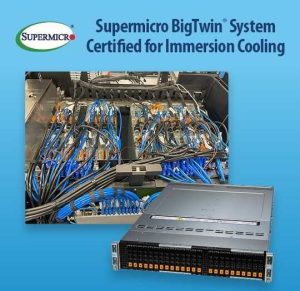 With rigorous testing, the Supermicro server, in combination with a defined liquid and immersion tank, is quality/performance tested and is now recognized as a certified immersion server. In addition, the BigTwin system has passed thorough testing as specified by the Open Compute Project (OCP) specification for material compatibility for immersion cooling.
With rigorous testing, the Supermicro server, in combination with a defined liquid and immersion tank, is quality/performance tested and is now recognized as a certified immersion server. In addition, the BigTwin system has passed thorough testing as specified by the Open Compute Project (OCP) specification for material compatibility for immersion cooling.
“Supermicro’s collaboration with Intel is a long-standing, strategic association that combines Intel’s cutting-edge processor technologies with Supermicro’s high-performance building block solutions, including AI, HPC, intelligent edge/IoT, networking, and storage,” said Ray Pang, SVP, technology enablement, Supermicro. “Certifying our BigTwin server for immersion cooling within the Intel and OCP guidelines and practices ensures customers that their Supermicro server will be fully functional when immersed in the specified liquid.“
The firm’s immersion-certified servers can significantly lower Power Usage Effectiveness (PUE) by leveraging advanced immersion cooling technology that eliminates the need for traditional air-based cooling systems. By submerging factory built high-density, fanless servers directly in dielectric fluid, heat dissipates much more efficiently than with air, reducing the energy required for cooling solutions like CRAC and CRAH units. This approach not only minimizes cooling overhead but also allows denser compute configurations without increasing thermal load. Furthermore, removing internal server fans decreases overall IT equipment power consumption, which improves the Power Usage Effectiveness (PUE). Consequently, data centers using the company’s immersion servers are capable of achieving PUE values close to 1.05 or lower, significantly reducing energy costs and environmental impact for the entire data center.
“Intel worked hand-in-hand with Supermicro, along with key tank and fluid providers, to certify their multi-node BigTwin system, passing the rigorous testing that immersion cooling requires,” said Rami Khouri, VP, platform engineering group GM, data center hardware engineering, Intel. “This first-of-its-kind solution, known as Intel Data Center Certified for Immersion Cooling, ensures that Supermicro customers can be confident that the BigTwin systems will continue to perform as expected and give its data center customers a clear path to sustainable, efficient cooling in the AI era.”
Supermicro, as a member of the Open Compute Project (OCP) Advisory Board, has played a critical role within the OCP Community. The Open Compute Project immersion cooling recommendations offer significant advantages by ensuring compatibility, efficiency, and scalability across data center deployments. These guidelines promote standardized hardware interfaces, fluid specifications, and operational best practices that simplify the integration and maintenance of immersion-cooled systems.
“We are grateful for the role that Supermicro has played within the OCP Community, and eager to see what the future holds,” Michael Schill, senior director of community, Open Compute Project Foundation. “The leadership and industry expertise contributed by the Supermicro team has been instrumental in driving innovation forward, not only within the Immersion Subproject, but across the entire OCP Community.“
Utilizing Supermicro’s BigTwin immersion servers alongside Intel’s Advanced Data Center Development Laboratory (ADDL) immersion cooling technology involves submerging server components in a thermally conductive dielectric fluid. This method effectively dissipates heat, enabling enhanced performance and reduced energy consumption compared to traditional air cooling. The company’s BigTwin servers have shown reliability within the OCP specifications and allow data centers to achieve improved thermal management and operational efficiency.
The BigTwin server architecture is a high-density, multi-node platform designed to deliver performance and efficiency for demanding workloads. When paired with Intel’s advanced data center liquid immersion cooling solution, BigTwin servers offer a compelling combination of computational power and thermal management.
Specifically, the now certified system tested consisted of:
- BigTwin SuperServer SYS-221BT-HNTR
Hot-pluggable node
- 4 hot-pluggable systems (nodes) in a 2U form factor. Each node supports following:
- Socket E (LGA 4677) support 5th/4th Gen Xeon Scalable processors Intel C741
- 16 DIMM Slots supporting up to 4TB of memory; ECC RDIMMs up to DDR5-5600
- 2 PCIe 5.0 x16 (LP) slot;
- Tool-less support
- Internal PCIe 4.0 for 2 x4 M.2 NVMe support onboard
- Optional M.2 (22×80) HW RAID-1 NVMe Boot Controller via SCC-A2NM2241G3-B1
- Network connectivity via AIOM (OCP 3.0 compliant)
- 3000W Redundant Power Supplies Titanium Level (96%+); Shared Power Design
BigTwin SuperServer SYS-221BT-HNTR front
BigTwin SuperServer SYS-221BT-HNTR rear
The work surrounding Intel’s ADDL immersion solution – especially in collaboration with Supermicro and other ecosystem partners – has significantly advanced the Open Compute Project (OCP) immersion cooling standards, particularly in defining acceptable operating conditions, safety, and component reliability within immersion environments.
The growing demand for immersion-certified servers, particularly the company’s offerings, arises from the increasing need for highly efficient cooling solutions in data centers, especially as AI and HPC applications require increasingly powerful processors. Immersion cooling offers a more efficient and sustainable way to manage the heat generated by these processors compared to traditional air-cooling methods and can reduce the PUE in a data center to nearly 1.0.
Resource:
Supermicro’s liquid cooling solutions








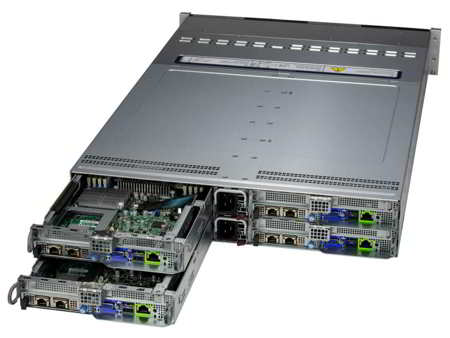
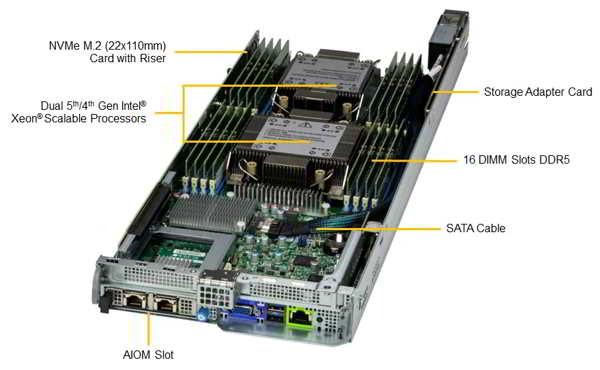
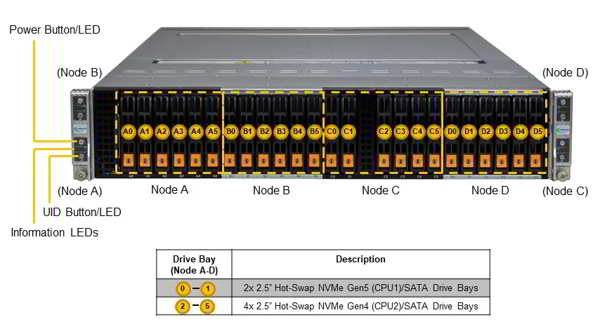
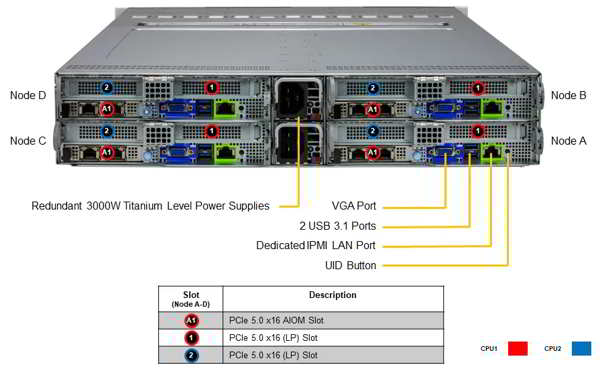






 Subscribe to our free daily newsletter
Subscribe to our free daily newsletter


